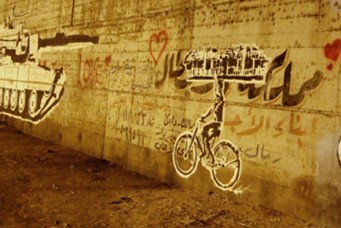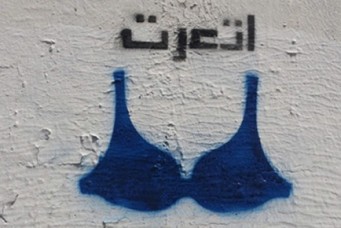A Street Called Mohammed Mahmoud
The walls of Mohammed Mahmoud Street, with their vibrant murals portraying the unflinching gaze of blinded protesters, or the serene smiles of winged martyrs, are witness to the wounds of Egypt’s ongoing revolution.
Some have proposed renaming it Eyes of Freedom Street. Many of the uprising’s most violent clashes have occurred on this avenue, giving it a powerful symbolic charge recognized by protesters and regime forces alike. The walls of Mohammed Mahmoud Street, with their vibrant murals portraying the unflinching gaze of blinded protesters, or the serene smiles of winged martyrs, are witness to the wounds of Egypt’s ongoing revolution.
Beyond an impressively high level of technique, the symbolic and emotional qualities of the murals embody collective grievance. The life-like images invite contemplation and mourning—rendering all those fallen Egyptians as familiar as family. Images of the young dead rendered as angels appear next to portraits of grieving mothers who clutch picture frames. The picture frames seem to not merely suggest participation—but demand it. Friends, family, and passersby routinely leave letters, goodbye notes, and meta-commentary proclaiming that the sacrifices of the martyrs would not go in vain.
More than as a barometer of public sentiment, the proliferation of street art since the January 25, 2011 uprising is best understood as a constituent part of the country’s evolving civil society—an active component of participatory democracy. The contemporary genre of street art known as graffiti is rooted in urban American resistance culture, and particularly owes to socially and economically marginalized community youth of 1970s New York. Egypt’s revolutionary public art owes as much to a strong local tradition as to any foreign precedent. The themes of graffiti emerging in 2011 expressed grievances shared across borders in the Middle East but with local inflections—and the case of Egypt stands out.
At a superficial level, Egyptian political graffiti evokes easy reference to the acerbic wit aimed at public figures, from the satirical papyri mocking the pharaohs of ancient Egypt to jokes circulating in the last years of Hosni Mubarak’s reign. An important inspiration is the Egyptian folk art of hajj murals: the creation of commemorative paintings featuring boats and planes on the facades of homes to celebrate a pilgrim’s safe return and advertise the returnee’s new status. It is not only the decoration of public spaces that links the art of pilgrimage to that of political rebellion, but the emphasis placed by such religious commemorations on communal experience and interactivity.
Decorating a wall thus means to advertise adherence to normative morality, bear witness to pride, and make a statement in the public space—intended, inherently, to be shared. Hajj murals sanctify domestic spaces, and by extension, the wider community. Contemporary street art operates in a similar manner albeit inverted—the sentiment evoked is not one of communal blessing, but shared anger. Like the monumental size of hajj paintings, revolutionary murals engulf the viewer. The populist political art of graffiti offers a meditation on shared losses and unifying grievances; such murals necessitate not a simple viewing, but a spatial experience.
With its location in the heart of downtown Cairo, Mohammed Mahmoud provides an ideal forum for everyday people to express grievances. This broad pathway connecting the traffic hub of Tahrir Square to the hated Interior Ministry has been so frequently visited by multiple battles that it seems as if the strip has become a perpetual scar: fresh graffiti covers the scabs of each progressive wound.
Ten months after the revolution’s early skirmishes, security forces stormed a Tahrir sit-in; protestors streamed back to the square—and the Battle of Mohammed Mahmoud had begun. Some forty demonstrators lost their lives, and snipers blinded more than sixty others in the crowd. Somber images of sightless protestors emerged on the walls to keep watch over the revolution. Ammar Abu Bakr, an art teacher from Luxor, depicted the state’s violence and protestors’ resilience in monumental portraits of eighteen of the blinded protestors drawn in patriotic colors.
Just before the first anniversary of January 25, regime forces blinded Egypt again—and erased the faces of Mohammed Mahmoud. On February 2, 2012, clouds of tear gas once more choked the street and new martyrs flowed from Abu Bakr’s brush as another battle raged on. The evening before, a rampage at a football match in Port Said killed seventy-four fans in an act widely perceived as having been actively facilitated by state security forces.
In September 2012, the news that someone once again had painted over the murals on Mohammed Mahmoud Street aroused attention on Twitter and Facebook. Trained and amateur artists, flanked by onlookers, returned immediately with spray cans, paint, and fury. Some pointed fingers of blame at the government—then dominated by Islamists—interpreting the destruction as a crackdown on art, expression, and even figuration. Others viewed the whitewashing as an attack on Egypt’s pluralistic history embodied in the mix of Pharaonic, Christian, and Muslim imagery.
The latest erasure was rightfully understood as an attack on the public space, and by extension, the voices expressed on the open walls. Whitewashing graffiti is one thing (the art is, after all, inherently ephemeral), but whitewashing memory proves impossible—something confirmed by the content of the graffiti’s swift return.
New portraits depicted not fallen martyrs, but defiance. The image of a young man with unkempt long hair sticks out his tongue; scrawled beneath, a caption mockingly refers to the state’s secretive plan and dead-of-night timing: “Erase it again, regime of cowards.” A new mural proclaimed Egypt as the Muslim Brotherhood’s future graveyard—foretelling the new uprising, in the summer of 2013, that forced Islamist president Mohammed Morsi out of office. As targets of public opprobrium shift, so too will their artistic meta-texts—evolving as the structures of oppression become increasingly clearer to a population unhappy with the unfulfilled promises of revolution.
The revitalization of civil society in the aftermath of revolution will emerge from the organic permutations of cultural idioms and local precedents. The Hosni Mubarak-era barrier of fear has been broken, and ink spills outside the frame all over the open spaces of contemporary Egypt.
Amanda E. Rogers is the A.W. Mellon Postdoctoral Fellow in Art History at the University of Wisconsin–Madison.



